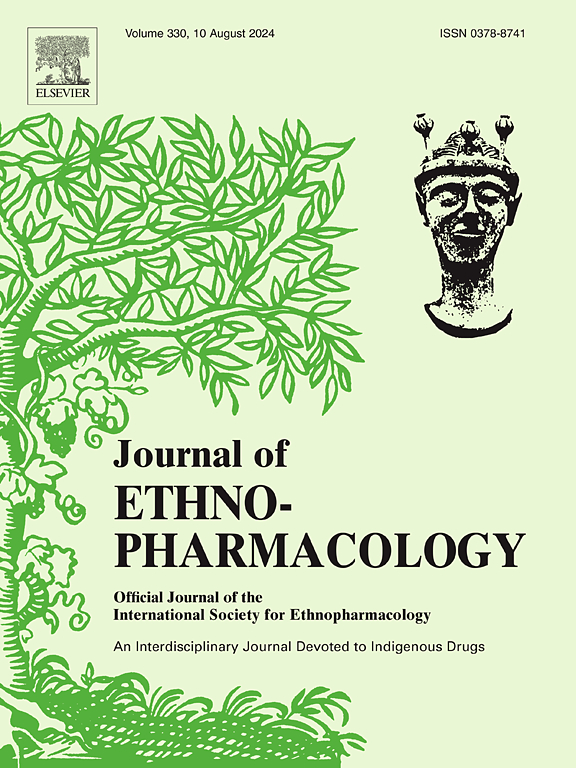Chaihu-Shugan-San Alleviates Post-Stroke Depression in Mice: Mechanistic Insights into Exosome-Mediated Neuroprotection
IF 4.8
2区 医学
Q1 CHEMISTRY, MEDICINAL
引用次数: 0
Abstract
Ethnopharmacological relevance
Post-stroke depression (PSD) is common among stroke survivors and negatively impacts recovery. Chaihu-Shugan-San (CSS), a traditional Chinese medicine, has shown therapeutic potential for mood disorders, particularly PSD. Recent studies suggest that CSS’s effects may be mediated by exosomes, but the mechanisms remain unclear.
Aim of study
This study aimed to evaluate the therapeutic effects of CSS on PSD in mice and investigate the underlying mechanisms, particularly the role of exosomes.
Materials and methods
Active compounds in CSS were identified from rat serum using liquid chromatography-mass spectrometry (LC-MS) and analyzed through network pharmacology. In vitro, an oxygen-glucose deprivation/reperfusion (OGD/R) BV2 microglia model was used to assess the effects of CSS-containing serum (CSS-S). Exosomes from OGD/R-treated BV2 microglia were isolated, labeled with PKH26, and analyzed using transmission electron microscopy (TEM) and nanoparticle tracking analysis (NTA). In vivo, a photothrombotic stroke (PT) model combined with chronic unpredictable mild stress (CUMS) was used to induce PSD in mice. Behavioral assessments and histological analysis were performed, along with immunofluorescence (IF), ELISA and q-PCR to measure key protein and miR-146 expression in the hippocampus.
Results
CSS treatment significantly alleviated depressive-like behaviors in the PSD mouse model. Mice treated with high-dose CSS (4.2 g/kg) exhibited increased sucrose preference, reduced immobility in the tail suspension test (TST) and forced swimming test (FST), and enhanced exploratory activity in the open field test (OFT). Histological analysis demonstrated that CSS treatment improved brain tissue integrity, alleviating neuronal damage and reducing neuroinflammation. Exosome analysis revealed that CSS increased the expression of microglia-derived exosomes in the hippocampus, which were shown to carry miR-146. Further examination of miR-146 isoforms in the hippocampal tissue revealed significant changes: miR-146b-3p and miR-146a-5p were upregulated, while miR-146a-3p and miR-146b-5p were downregulated in PSD mice. Treatment with CSS reversed the altered miRNA expression, indicating a potential mechanism for its neuroprotective effects. Additionally, CSS treatment reduced the expression of inflammatory cytokines such as S100A8, IL1β, IL6, and TNF-α, while restoring the levels of angiogenic factors VEGFC and VEGFR3. ELISA measurements showed significant decreases in cyclic AMP response element-binding protein (CREB), brain-derived neurotrophic factor (BDNF), 5-hydroxytryptamine (5-HT), dopamine (DA), and noradrenaline (NE) in PSD mice; high-dose CSS notably elevated CREB and BDNF levels and showed comparable effects to fluoxetine in restoring 5-HT and DA levels. Additionally, the calcium signaling pathway was implicated, with altered mRNA expressions of CaMKIIα, CREB, phosphorylated CREB (p-CREB), PDE4D, and BDNF, although fluoxetine demonstrated stronger modulatory effects than CSS.
Conclusions
CSS alleviates PSD in mice by modulating exosome-mediated signaling, particularly through the regulation of miR-146. The treatment reversed abnormal miRNA expression, reduced neuroinflammation, and improved synaptic function. These findings highlight CSS’s potential as an effective therapeutic strategy for PSD by targeting exosome-mediated neuroprotection and miR-146 regulation.

求助全文
约1分钟内获得全文
求助全文
来源期刊

Journal of ethnopharmacology
医学-全科医学与补充医学
CiteScore
10.30
自引率
5.60%
发文量
967
审稿时长
77 days
期刊介绍:
The Journal of Ethnopharmacology is dedicated to the exchange of information and understandings about people''s use of plants, fungi, animals, microorganisms and minerals and their biological and pharmacological effects based on the principles established through international conventions. Early people confronted with illness and disease, discovered a wealth of useful therapeutic agents in the plant and animal kingdoms. The empirical knowledge of these medicinal substances and their toxic potential was passed on by oral tradition and sometimes recorded in herbals and other texts on materia medica. Many valuable drugs of today (e.g., atropine, ephedrine, tubocurarine, digoxin, reserpine) came into use through the study of indigenous remedies. Chemists continue to use plant-derived drugs (e.g., morphine, taxol, physostigmine, quinidine, emetine) as prototypes in their attempts to develop more effective and less toxic medicinals.
 求助内容:
求助内容: 应助结果提醒方式:
应助结果提醒方式:


